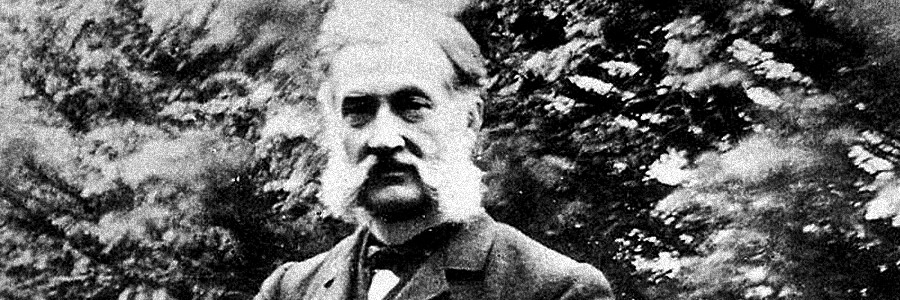
The Curious Case Of Louis Le Prince
Whitley Partners
Release date: October 14th, 1888
Certificate: N/A
Running time: 2.11 seconds
Director: Louis Aimé Augustin Le Prince
Cast: Harriet Hartley, Adolphe Le Prince, Joseph Whitley, Sarah Whitley
The name Louis Aimé Augustin Le Prince might not be one you’re immediately familiar with, but believe me when I say we have a lot to be thankful to this pioneering filmmaker for.
Born in Metz, France on August 28th, 1841 he was an inventor with a background in photography and chemistry. After serving in the Franco-Prussian War, Louis returned to the Britain where he had been living with his wife, Lizzie Whitley, and together they set up an art school in Park Square, Leeds.
In 1881 they moved to America where Lizzie got a job with the New York Institute for the Deaf and where Louis began experimenting with moving picture machines.

His breakthrough came on October 14th, 1888 when he managed to record a moving piece of film. Lasting only 2.11 seconds, the scene captures Adolphe Le Prince (Louis’ son), Sarah Robinson Whitley (Louis’ mother-in-law), Joseph Whitley and Harriet Hartley walking around in a garden. By today’s standards it sounds like nothing exciting, but back then, who had seen such a thing before?
Eadweard Muybridge presented Sallie Gardner at a Gallop (aka The Horse in Motion) a decade earlier, consisting of 24 photographs in a fast-motion series shown on a zoopraxiscope. This was something else entirely.
Shot at 12 frames per second in Roundhay, Leeds, at the home of Joseph and Sarah Whitley, it’s a film of remarkable historical and technological importance. As a window back in time we get a glimpse of life in the late 19th century with a British middle-class family. As they walk in circles, remaining in the picture’s frame, they can be seen laughing and in the short time it lasts, it also looks as if they are talking to each other. What we see is not a set and the figures are not dressed in costumes, this really is 1888.

Recorded on Eastman Kodak paper base photographic film from 1885 through Louis’s single-lens combi camera-projector, the filmstrip is thought to be not only the oldest surviving piece of film, but also the first. If this is the case, then his Roundhay Garden Scene predates anything by Thomas Edison or the Lumière Brothers and surely it would have been documented and widely known, and that’s exactly why I cal it “the curious case”.
Although Louis applied for several patents for his work in Britain, France and America, financial difficulties would get the better of him and he packed up in 1890 to return to his wife in America. In the late summer of that year, after visiting in France with friends, Louis was last seen boarding a train from Bourges to Dijon, where his brother lived. He was never seen again.
Any hopes he had of being recognised as the true father of the motion picture were lost as he vanished before he was able to patent the new camera in Britain and demonstrate its operation in America. However, his work survives. Along with Roundhay Garden Scene, there’s also Leeds Bridge, a 6-frame sequence where Louis filmed the passing traffic on Leeds Bridge from an ironmongers. There’s also Man Walking Around A Corner and a 19-frame sequence called Accordion Player which shows Adolphe Le Prince playing a diatonic button accordion.
- Christopher Rawlence, The Missing Reel (1990), Athenum Publishers, New York
They are short, grainy and at first glance might not seem much, but these are the oldest known films we have, if not the first. Whether or not Louis met with foul play over a patent war with Edison is still up for debate, his body was never recovered. Whatever the case might be, it certainly is a curious one.

Patrick Samuel
The founder of Static Mass Emporium and one of its Editors in Chief is an emerging artist with a philosophy degree, working primarily with pastels and graphite pencils, but he also enjoys experimenting with water colours, acrylics, glass and oil paints.
Being on the autistic spectrum with Asperger’s Syndrome, he is stimulated by bold, contrasting colours, intricate details, multiple textures, and varying shades of light and dark. Patrick's work extends to sound and video, and when not drawing or painting, he can be found working on projects he shares online with his followers.
Patrick returned to drawing and painting after a prolonged break in December 2016 as part of his daily art therapy, and is now making the transition to being a full-time artist. As a spokesperson for autism awareness, he also gives talks and presentations on the benefits of creative therapy.
Static Mass is where he lives his passion for film and writing about it. A fan of film classics, documentaries and science fiction, Patrick prefers films with an impeccable way of storytelling that reflect on the human condition.
© 2022 STATIC MASS EMPORIUM . All Rights Reserved. Powered by METATEMPUS | creative.timeless.personal. | DISCLAIMER, TERMS & CONDITIONS
HOME | ABOUT | CONTACT | TWITTER | GOOGLE+ | FACEBOOK | TUMBLR | YOUTUBE | RSS FEED
CINEMA REVIEWS | BLU-RAY & DVD | THE EMPORIUM | DOCUMENTARIES | WORLD CINEMA | CULT MOVIES | INDIAN CINEMA | EARLY CINEMA
MOVIE CLASSICS | DECONSTRUCTING CINEMA | SOUNDTRACKS | INTERVIEWS | THE DIRECTOR’S CHAIR | JAPANESE CINEMA





